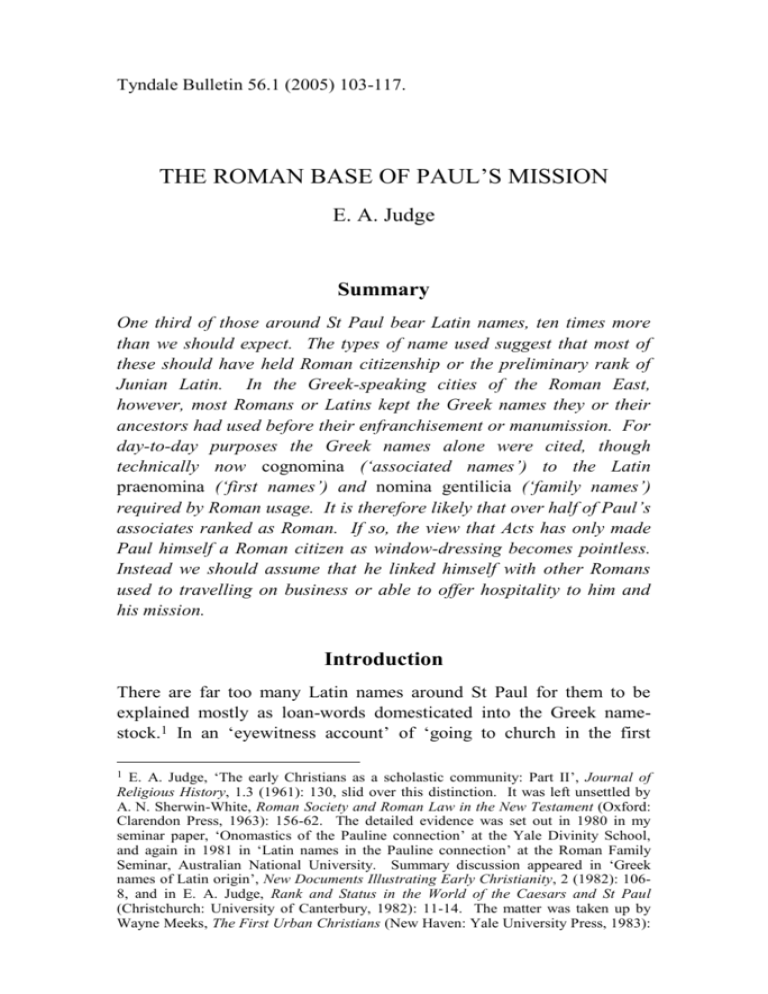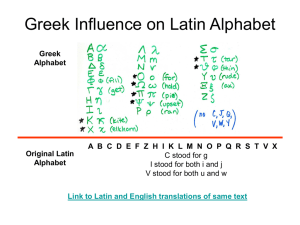Tyndale email addresses
advertisement

Tyndale Bulletin 56.1 (2005) 103-117. THE ROMAN BASE OF PAUL’S MISSION E. A. Judge Summary One third of those around St Paul bear Latin names, ten times more than we should expect. The types of name used suggest that most of these should have held Roman citizenship or the preliminary rank of Junian Latin. In the Greek-speaking cities of the Roman East, however, most Romans or Latins kept the Greek names they or their ancestors had used before their enfranchisement or manumission. For day-to-day purposes the Greek names alone were cited, though technically now cognomina (‘associated names’) to the Latin praenomina (‘first names’) and nomina gentilicia (‘family names’) required by Roman usage. It is therefore likely that over half of Paul’s associates ranked as Roman. If so, the view that Acts has only made Paul himself a Roman citizen as window-dressing becomes pointless. Instead we should assume that he linked himself with other Romans used to travelling on business or able to offer hospitality to him and his mission. Introduction There are far too many Latin names around St Paul for them to be explained mostly as loan-words domesticated into the Greek namestock.1 In an ‘eyewitness account’ of ‘going to church in the first E. A. Judge, ‘The early Christians as a scholastic community: Part II’, Journal of Religious History, 1.3 (1961): 130, slid over this distinction. It was left unsettled by A. N. Sherwin-White, Roman Society and Roman Law in the New Testament (Oxford: Clarendon Press, 1963): 156-62. The detailed evidence was set out in 1980 in my seminar paper, ‘Onomastics of the Pauline connection’ at the Yale Divinity School, and again in 1981 in ‘Latin names in the Pauline connection’ at the Roman Family Seminar, Australian National University. Summary discussion appeared in ‘Greek names of Latin origin’, New Documents Illustrating Early Christianity, 2 (1982): 1068, and in E. A. Judge, Rank and Status in the World of the Caesars and St Paul (Christchurch: University of Canterbury, 1982): 11-14. The matter was taken up by Wayne Meeks, The First Urban Christians (New Haven: Yale University Press, 1983): 1 104 TYNDALE BULLETIN 56.1 (2005) century’ we hear from one ‘Publius Valerius Amicius Rufus’. He was visiting Rome from Philippi.2 There is indeed a Publius Valerius Rufus of Philippi, attested in a Roman inscription, but a century later (AD 144).3 The additional cognomen (Amicius) is in any case improbable.4 Yet it was right to have taken the Rufus whose mother protected Paul (Rom. 16:13) as a Roman citizen. It was an historically dignified name. It is the inscriptions, whether civil documents or commemorative ones, with their necessary formality, which help us to establish distinctions of this kind.5 But statutes and tombstones may not take us 40-49, 55-63; by G. H. R. Horsley, New Documents Illustrating Early Christianity, 5 (1989): 108-13; and by G. W. Clarke, ‘The origins and spread of Christianity’ in The Cambridge Ancient History, 10, 2nd edn (Cambridge: Cambridge University Press, 1996): 864-65. The present article corrects and supplements ‘Latin names around a counter-cultural Paul’ in The Bible and the Business of Life, ed. S. C. Holt and Gordon Preece (Adelaide: ATF Press, 2004): 64-84. It also reflects the Tyndale House Annual Alumni Lecture given at San Antonio, 20 November 2004, entitled ‘If half Paul’s circle were Romans was he riding the wave of Romanisation?’ 2 Robert Banks, Going to Church in the First Century, 2nd edn (Sydney: Hexagon Press, 1985): 7. On p. 3 Edwin Judge is thanked ‘for checking its historical accuracy’. 3 Peter Pilhofer, Philippi, 2: Katalog der Inschriften von Philippi (Tübingen: Mohr/Siebeck, 2000): no. 762 (CIL 6.4.2, no.32520a; cf. CIL 6.1, no. 2379a, col. 3). Pilhofer indexes 577 names of Roman citizens from Philippi, 60 of them from Greek texts. 4 Ladislav Vidman, Index Cognominum (Berlin: de Gruyter, 1980 = CIL 6.6.2) lists five instances from Roman inscriptions, all miscopied from the form Amicus in the CIL texts. So much for the historical checking! No Amicius is indexed by Pilhofer for Philippi, nor for Thessalonica by Charles Edson, Inscriptiones Thessalonicae et Viciniae (Berlin: De Gruyter, 1972 = IG 10.2.1), nor for Ephesus by Johannes Nollé, Verzeichnis der Eigennamen (Bonn: Habelt, 1984 = IGSK 17.4.8.2). Double cognomina are not common, and very rare indeed before the second century. As a nomen gentilicium Amicius is attested in a theatre list from Herculaneum (CIL 10.1403). 5 Pilhofer and Edson (nn. 2 and 3 above) are the most convenient starting-points, each offering in one volume (for Philippi and Thessalonica respectively) all extant inscriptions, dated where plausible, along with onomastically classified indices of all named people. For Ephesus, Nollé has merged the names of people in one unclassified alphabetical order with other sorts of proper name (e.g. for places, tribes, gods). The inscriptions (three or four times more numerous than for Philippi or Thessalonica) are inconveniently reproduced in the eight preceding volumes (IGSK 17.4.1A to 7B), arranged on the basis of their earlier publication and often without the opinions on their dating offered by the previous editors. The Lexicon of Greek Personal Names (Oxford: Clarendon, 1987-) includes and dates named persons from all sources but omits Latin ones if a praenomen and nomen are combined, or if the two are tied to a Latin cognomen. Volume 2 (Attica, 1994) however includes these. Volume 1 (1987) covers the Aegean islands, Cyprus and Cyrenaica, Volume 3A (1997) the Peloponnesus, Western Greece, Sicily and Magna Graecia, and Volume 3B (2000) Central Greece. Yet to come are Macedonia, Asia Minor, the Levant and Egypt. For Rome (with ten times more inscriptions than at Ephesus) the easiest starting-point is now H. Solin, Die stadtrömischen Sklavennamen, JUDGE: Roman Base of Paul's Mission 105 to the heart of community life. They are just the first and last word on it. What was life like when not on display, and especially outside the cultivated circles which could afford that? The Pauline letters are just the kind of middle ground we want, neither incidental nor highly stylised. They document a variety of groups scattered along the main axis of the Roman world. They are moreover designed to exploit the social pattern in order to promote a radical re-modelling of communal life. Yet Paul is extraordinarily elusive in social terms. This is precisely because he will not use conventional classifications (culture, occupation, etc.) but devises his own epithets for people in their personal relationships, to make his new points. Although keenly interested in the obligations created by the Roman ranking system, for example, he avoids situating people within it (Gal. 2:3 is an exception). This makes the phenomenon of the Latin names around Paul doubly intriguing.6 To possess Roman citizenship in the first century gave one automatically a claim on the privileges and protection of the ruling power, throughout the Mediterranean world.7 This is dramatically highlighted in the case of Paul himself by the writer of Acts (16:21-38; 22:25-29). One might compare the status assumed by Americans throughout the world today. But there is a vital difference. To become a citizen of the United States one must first gain entry to their territory, and then qualify for citizenship. The Romans however allowed their (military) magistrates abroad to confer citizenship as a personal benefit. Thousands of minor republican or ethnic states had fallen under the aegis of the superpower of the day, each legally and territorially independent. But the Romans co-opted the loyalty of their elites by selectively granting Roman citizenship to people who had 3 vols (Stuttgart: Steiner, 1996), which systematically analyses both Latin and Greek servile names (normally kept by freedmen after their manumission). 6 The use of Latin names in the Greek East remains in need of systematic clarification: G. Daux, ‘L’onomastique romaine d’expression grecque’ in H. G. Pflaum and N. Duval (eds.), L’Onomastique latine (Paris: CNRS, 1975): 405-17; A. D. Rizakis, ‘Anthroponymie et société: les noms romains dans les provinces hellénophones de l’Empire’ in Roman Onomastics in the Greek East: Social and Political Aspects (Athens: Finnish Institute, 1996): 11-30: Heikki Solin, ‘Latin cognomina in the Greek East’ in The Greek East in the Roman Context, ed. Olli Salomies, (Helsinki: Finnish Institute at Athens, 2001): 189-202. 7 Peter Garnsey, Social Status and Legal Privilege in the Roman Empire (Oxford: Clarendon, 1970), argued that the later distinction in terms of social status (‘more honourable’ v. ‘more lowly’) had already undermined the privileges of citizenship, but reviewers questioned this. 106 TYNDALE BULLETIN 56.1 (2005) never been to Rome. It was an enlightened, common-sense approach to world citizenship such as utterly eludes us now. There were borders everywhere then, yet anyone could freely cross them. But was the imperial freedom only for the few? Paul in his letters claims no citizenship of Rome. So is Acts only indulging in retrospective respectability? One did not have to know the proconsul (cf. Sergius Paulus, Acts 13:7) to become a Roman citizen. Every citizen could co-opt others in effect, by purchasing (or breeding) them into slavery, and then formally manumitting them into citizenship. Informal manumission was the preferred usage, however, since the owner did not thereby lose his entitlement to inherit his freedman’s property. But the freedman still took the distinctive threefold name of a Roman, and could complete his emancipation either by having it formally repeated or by producing a legitimate heir with a Roman woman.8 Latin names also transplanted themselves across the Mediterranean world through Roman or Italian businessmen who settled abroad,9 or as the legionaries were discharged into colonies,10 or (starting in Paul’s day) when the (non-Roman) auxiliary forces were presented on discharge with their diploma of Latin status, and sported their new Latin names as badges of honour in their Greek-speaking home towns.11 The very common first names of Roman generals who had P. R. C. Weaver, ‘Where have all the Junian Latins gone? Nomenclature and status in the Early Empire’, Chiron 20 (1990): 275-304; ‘Children of Junian Latins’ in The Roman Family in Italy, ed. Beryl Rawson and Paul Weaver (Oxford: Clarendon, 1997): 55-72; P. López Barja de Quiroga, ‘Junian Latins: Status and number’, Athenaeum 86 (1998): 133-63. 9 Jean Hatzfeld, Les trafiquants italiens dans l’Orient hellénique (Paris: Boccard, 1919; repr. New York: Arno, 1978); A. J. N. Wilson, Emigration from Italy in the Republican Age of Rome (Manchester: Manchester University Press, 1996); H. W. Pleket, ‘Urban élites and business in the Greek part of the Roman Empire’ in Trade in the Ancient Economy, ed. Peter Garnsey et al., (Berkeley: University of California Press, 1983), 131-44. 10 L. R. Dean, A Study of the Cognomina of Soldiers in the Roman Legions (dissertation, Princeton, 1916); Barbara Levick, ‘The origin of the colonists’, ch. 6 in Roman Colonies in Southern Asia Minor (Oxford: Clarendon, 1967): 56-67. 11 D. B. Saddington, The Development of the Roman Auxiliary Forces from Caesar to Vespasian (49 BC to AD 79) (Harare: University of Zimbabwe, 1982); ‘The sorts of names used by auxiliaries in the Early Principate’ in Kaiser, Heer und Gesellschaft in der römischen Kaiserzeit, ed. Géza Alföldy et al. (Stuttgart: Steiner, 2000): 163-78. 8 JUDGE: Roman Base of Paul's Mission 107 overthrown Hellenistic monarchies had in any case long before this been converted into Greek personal names, as people aped their liberators.12 It is this last phenomenon which has apparently sometimes led such New Testament commentators as have noticed the matter to assume that the Latin names around St Paul are those of Greeks and not of Romans. My problem is that there are ten times too many of them. This is clearly demonstrable, at least for Greeks of good standing in their own cities. In table 1 the tallies of three percent Greeks with Latin names seem to be roughly matched by those in the indexes of Pilhofer, Edson and Nollé for Philippi, Thessalonica and Ephesus respectively (nn. 2 and 3 above). Table 1: Frequency of Latin Names in Greek Cities (a) (b) (c) (d) Imperial Greeks 43 BC–AD 96 Byzantine epitaphs IIa–IIp Ephesian eulogies IIa–IIp Ephesian traders AD 54–59 % Roman cognomina Latin / Greek % Greek names Latin / Greek Total no. of people 5/9 3 / 83 1064 2/2 3 / 89 314 9/2 — / 89 79 19 / 23 — / 46 91 (a) From all Greek-language texts reproduced in Victor Ehrenberg and A. H. M. Jones, Documents Illustrating the Reigns of Augustus and Tiberius, 2nd edn (Oxford: Clarendon, 1967); E. Mary Smallwood, Documents Illustrating the Principates of Gaius, Claudius and Nero (Cambridge: Cambridge University Press, 1967); M. McCrum and A. G. Woodhead, Select Documents of the Principates of the Flavian Emperors (Cambridge: Cambridge University Press, 1966). (b) From all Greek-language texts dateable from 2nd century BC to 2nd century AD in N. Firatlı, Les stèles funéraires de Byzance gréco-romaine (Paris: Maisonneuve, 1964), ed. Louis Robert, excluding the 4% who are Romans without cognomen. (c) From fifty Greek-language honorific texts dateable from 2nd century BC to 2nd century AD in IGSK 17.4.1A to 7B (notes 3 and 5 above), as listed in ‘Ephesus and the World of St Paul’, Macquarie University 1993 Seminar Papers. (d) All persons listed in IGSK 17.4.1A.20, reprinted by G. H. R. Horsley (note 4 above), excluding the 7% who are Romans without cognomen and the 5% who are taken as slaves, 2% of whom have Latin names; 28% in all thus match the raw figure of 25 in table 3b. 12 Wilhelm Schulze, Zur Geschichte lateinischer Eigennamen Abhandlungen ... V 5, 1904; repr. Berlin: Weidmann, 1996): 506-14. (Göttingen: 108 TYNDALE BULLETIN 56.1 (2005) By the mid-first century up to three percent of such people might be using Latin names, but around St Paul it is more than thirty percent. We might have to say either that the latinising fashion in names had caught on far more at levels below that of the local elites (assuming, as some people still do, that Paul operated well down the social scale), or that Paul is picking up strong support not only from Greeks but from the various sorts of Roman by now well settled in the Greek East. But of course we need not make these two possibilities exclude each other. Table 2: Frequency of Latin Names around St Paul (a) (b) (c) (d) (e) With Paul in the Acts or Epistles Only in the Acts or Pastorals Paul’s ‘relatives’ (syngeneis) Women around St Paul Paul’s ‘collaborators’ (synergoi) At least one Latin name Only non-Latin names Total no. of people 31 60 91 10 21 31 2 4 6 5 13 18 8 5 13 (c) Lucius, Jason and Sosipater (Rom. 16:21), Andronicus and Junia (Rom. 16:7), Herodion (Rom. 16:11), the two names italicised being Latin. (d) The Latin-named women are Lydia (unless as Pilhofer argues this is her nationality, Acts 16:4), Prisca (Rom. 16:3), Junia (Rom. 16:7), Julia (Rom. 16:15), Claudia (2 Tim. 4:21). Maria (Rom. 16:6) could also be Latin, but more likely Hebrew. (e) Prisca and Aquila (Rom. 16:3), Urbanus (Rom. 16:9), Timothy (Rom. 16:21), Titus (2 Cor. 8:23), Epaphroditus (Phil. 2:25), Clement (Phil. 4:3), Mark, Aristarchus, Demas and Luke (Phlm. 24), Philemon (Phlm. 1), Jesus Justus (Col. 4:11), the eight names italicised being Latin. Table 2 attempts to dodge the strikingly high ratio (over 33%) of Latin names around St Paul, but the feature is not easily side-stepped. It has not been caused by counting the Acts of the Apostles and the Pastoral Epistles (table 2b) along with the other Pauline letters (mostly uncontested as to authorship). The ratio is virtually identical. The same goes for the small network (?) of Paul’s ‘relatives’ (2c). It is somewhat lower for the women linked to him (2d), while emphatically greater with those he calls ‘collaborators’ (2e). This may point to the explanation we seek. By people ‘around’ St Paul I mean only those mentioned by name who seem linked with his mission to the extent of sharing it in some way (travelling for him, or giving hospitality). JUDGE: Roman Base of Paul's Mission 109 Excluded, for example, is Mnason (Acts 21:16), the early disciple with whom Paul’s party was lodged in Jerusalem but not apparently through his own contacts. Table 3: Pauline Latin-name frequency compared with others (a) (b) (c) (d) (e) (f) With Paul in the Acts or Epistles Ephesian traders, AD 54–59 Corinthian potters IIp/IIIp Aphrodisian Jews IIp/IIIp Aphrodisian Godfearers IIp/IIIp Jews at Rome At least one Latin name Only non-Latin names Total no. of people 31 60 91 25 66 91 18 30 48 12 90 102 11 333 55 373 66 706 (b) Table 1(d). (c) E. A. Judge, ‘Greek names of Latin origin’, New Documents Illustrating Early Christianity 2 (1982): 107, for details of two published collections of the signatures of lamp manufacturers at Corinth and Isthmia. (d) E. A. Judge, ‘Jews, proselytes and God-fearers club together’, New Documents Illustrating Early Christianity 9 (2002): 73-80; detailed discussion of the names in Joyce Reynolds and Robert Tannenbaum, Jews and Godfearers at Aphrodisias (Cambridge: Cambridge University Press, 1987). (f) David Noy, Jewish Inscriptions of Western Europe, 2: The City of Rome (Cambridge: Cambridge University Press, 1995). Table 3 attempts to match the Pauline ratio of Latin names in other groups. Closest in a suggestive degree (but still lower) is the catalogue of fishing industry traders (table 1d) who subscribed to the new tollhouse at Ephesus while Paul was there. But the total of 91 names in either case is a mere coincidence, while those around St Paul in Ephesus, of all places, show not a single Latin name (table 4f). The Corinthian potters show a higher ratio than Paul’s 33%, but they come from a century or two later. Compared with them the Aphrodisian God-fearers (3e), from a broadly similar time, have a much lower Latin ratio, while the Jews there show a smaller proportion still of Latin names (3d). Yet Aphrodisias prided itself on its loyalty to the Caesars, and at Rome (3f) the Jewish community over its whole history easily outstrips Paul’s ratio. In all this one must remember that though 110 TYNDALE BULLETIN 56.1 (2005) trading activity peaked around the turn of the eras (as implied by the peak survival rates of both hard currency and shipwrecks), the peak period for surviving inscriptions is the second and later centuries AD. Table 4: Regional Tallies for Latin Names around St Paul (a) Antioch + Cyprus and Cyrene (b) Corinth + Cenchreae (c) Galatia + Lystra and Derbe (d) Rome (i) greeted in Rom. 16 (ii) greeters in Col. + 2 Tim. (e) Philippi + Thessalonica, Beroea, Athens (f) Ephesus + Asia, Troas, Crete, Colossae, Laodicea Total no. of people At least one Latin name praenomina 9 6 3 — 3 18 10 2 1 8* 5 2 1 — 1 21 5 — 2 3 6 4 — 1 3 13 4 1 — 3 19 — — — — 91 31 7 4 21* nomina cognomina Regions are in descending order of their ratio of Latin to non-Latin named people * Titius Justus is counted for nomen and cognomen separately. Table 4 groups the people with Latin names according to the region with which they seem to be primarily associated. Obviously this is too loose a category to carry much weight, and many of the people in any case were on the move from one place to another, indeed that is a dominant characteristic of those ‘around’ St Paul. My basic list (from which these tables are derived) was however settled through case by case judgements before I had any inkling of what particular questions might arise. I recognise that my figures for Rome (4d) are the result of combining names from Romans 16 (which some have suggested was only attached when a copy of the letter was sent to Ephesus) with those from Colossians (thought by some to have been written from Ephesus) and those from 2 Timothy (provenance not clearly indicated), but Rome is the generally preferred point of reference in each case. Accepting that, Rome occupies the middle ground in the table, closely JUDGE: Roman Base of Paul's Mission 111 flanked by Galatia and Philippi, while Antioch and Corinth outstrip Rome in the ratio of Latin names, and Ephesus is left with none. This tantalising result is worth preserving to see where it might lead. Roman names (table 5) began with the praenomen in the case of men.13 Only a handful were strongly favoured. It was these nevertheless which functioned as the equivalent of the Greek individual name, and which were taken over by Greeks from the second century BC. When such a Greek was later granted Roman citizenship he took a new praenomen and nomen (gentilicium) in honour of his new benefactor, his existing Greek name being kept as a cognomen. Thus what were once Latin praenomina came to be (in such cases) cognomina, and even in rare cases (as with Gaius) a nomen. The holders of a Latin praenomen in the New Testament will only have been Roman citizens if they happened to have acquired it this way (we can never know, and it is statistically very unlikely). By that time the cognomen had become the normal individual name, and in the vast majority of cases recently enfranchised Romans would therefore have been referred to by their former Greek name (now their cognomen), their Roman status only emerging when their full three names were given in a formal document. The nomen (gentilicium) was the family name, inherited from the father at birth. Daughters received this name (in the feminine form) and no other was needed. It remained their name after marriage. 14 This decisively paternal imprint clearly marks a person as a Roman citizen by birth. Someone enfranchised later would continue to be known by their former name, now attached as a cognomen to their new nomen, which in turn would not be displayed except for formal purposes. The New Testament nomina therefore most probably signify inherited citizenship, just as clearly as the (apparent) praenomina most probably signify non-citizenship. 13 Olli Salomies, Die römischen Vornamen (Helsinki: Societas Scientiarum Fennica, 1987). For a summary account of the Roman system see H. Rix, ‘Römische Personennamen’ in Namenforschung: Ein internationales Handbuch zur Onomastik, 1 (Berlin: de Gruyter, 1995): 724-32; H. Solin, ‘Names, personal, Roman’ in Oxford Classical Dictionary, 3rd edn (Oxford: Clarendon, 1996): 1024-26. 14 Mika Kajava, Roman Female Praenomina (Rome: Institutum Romanum Finlandiae, 1994) amasses for the first time the evidence for the various adaptations of the usual rule. 112 TYNDALE BULLETIN 56.1 (2005) Table 5: The Pauline Latin Names by Type (a) Praenomina (normally not Roman citizens) Mark (Acts 12:12), ‘also called’ implies not Lucius (Acts 13:1), ‘of Cyrene’ implies not Titus (Gal. 2:3), ‘being a Greek’ implies not Gaius (Acts 20:4), ‘of Derbe’ implies not Gaius (Acts 19:29), ‘Macedonian’ implies not Gaius (Rom. 16:23), as ‘host’ at Corinth, should be Lucius (Rom. 16:21), hangs on meaning of ‘relative’ (b) Nomina (should always imply Roman citizenship) Titius (Acts 18:7), confirmed by cognomen Junia (Rom. 16:7), feminine form decisive Julia (Rom. 16:15), feminine form decisive Claudia (2 Tim. 4:21), feminine form decisive (c) Cognomina (should mostly imply Roman citizenship): Paul (Acts 13:9) Niger (Acts 13:1) Crispus (Acts 18:8) Rufus (Rom. 16:13) Pudens (2 Tim. 4:21) Silvanus (2 Cor. 1:19) Aquila (Acts 18:2) Priscus (Acts 18:2) Secundus (Acts 20:4) Justus (Acts 18:7) Justus* (Col. 4:11) Fortunatus* (1 Cor. 16:17) Clement (Phil. 4:3) Crescens (2 Tim. 4:10) Quartus (Rom. 16:23) Urbanus (Rom. 16:9) Tertius* (Rom. 16:22) Ampliatus* (Rom. 16:8) Achaicus* (1 Cor. 16:17) Total Romans / unclassified Philippi Thessalonica Ephesus 1/2 3/1 5/1 11 / 2 3/— 1/— —/— 10 / 1 18 / 1 1/— 5/2 3/— 2/2 9/2 1/— 1/— 4/— 6/— 20 / 8 7/— 33 / 27 2/— 6/— 42 / 11 1/— 5/— 2/2 17 / 4 16 / 10 3/2 5/— 1/— 4/— 3/— 2/— 3/1 —/— —/— 71 / 9 —/2 —/— 2/— 2/1 2/— 3/4 —/— —/— 67 / 23 —/1 2/— —/— 6/1 —/1 7/— —/2 —/— 142 / 61 * May as well be Greeks (or servile). The tallies are not exact. Some derivative forms of the names are included. Feminine forms are included (Priscus stands in above for Priscilla). Omitted are cases where other onomastic detail points to the Flavian or a later period. The cognomen began as a badge of nobility, lending a more individual distinction to prominent holders of what may well have been now a very ordinary praenomen and nomen (the wealthier a nobleman the more his nomen would have been vulgarised in the community through frequent manumissions from his household). In the time of Cicero there were still a few prominent people, and numerous others, without JUDGE: Roman Base of Paul's Mission 113 a cognomen. Subtle distinctions can be traced, as to how the three names could be variously employed, alone or in pairs.15 But a century later, in New Testament times, the cognomen was almost universal, and driving the others out of common currency. A fourth name might now be attached to allow individuality. It came to be called the agnomen, and in the Middle Ages the supernomen (‘surname’).16 The Latin cognomina of the New Testament should imply Roman citizenship, except where they are referred to in the text as extra names. Jews in particular might adopt a fine-sounding Latin name (e.g. Justus) for common use, their Hebrew one perhaps being echoed in the lingua franca. In table 5 the cognomina are listed in order of their social impressiveness in the streets of Rome, as judged by their relative frequency in senatorial families, as soldiers’ names, and (inversely) as servile ones. The accompanying tallies register their attestation in three Pauline cities. The overall implication is that only one quarter of those bearing such names (93 out of 373) might not be Roman citizens. At Ephesus this rises more towards one third, and at Philippi sinks to one eighth. I have marked with an asterisk those whom I can easily imagine as Greek (or servile) rather than as Roman citizens. The only cognomina not listed are Lydia, attested under Trajan for the wife of Claudius Aristion, the magnate of Ephesus, in IGSK 17.4.2.424a, and Luke. The name Loukas is not likely to appear in formal documents since it is a hypocoristic contraction (presumably of Lucanus), that is, a nick-name. Table 6: New Testament nomina with Greek cognomina Claudius Cornelius Julius Junius Pontius Philippi Latin / Greek Thessalonica Latin / Greek Ephesus Latin / Greek Total Latin / Greek 5/2 7/— 15 / 3 2/— 2/— 15 / 38 6/5 27 / 44 1/3 7/3 14 / 16 18 / 16 54 / 65 3/6 —/1 34 / 56 31 / 21 96 / 112 6/9 9/4 J. N. Adams, ‘Conventions of naming in Cicero’, Classical Quarterly 28 (1978): 145-66; Beryl Rawson, ‘The Roman name’ in The Politics of Friendship: Pompey and Cicero (Sydney: Sydney University Press, 1978): 199-200. 16 Iiro Kajanto, Supernomina: A Study in Latin Epigraphy (Helsinki: Soc. Sci. Fenn., 1967); Olli Salomies, Adoptive and Polyonymous Nomenclature in the Roman Empire (Helsinki: Soc. Sci. Fenn., 1992). 15 114 TYNDALE BULLETIN 56.1 (2005) Sergius Titius Valerius —/— —/1 16 / 7 47 /13 —/1 —/— 2/7 58 / 101 2/— 3/1 6 /6 100 / 111 2/1 3/2 24 / 20 205 / 225 Texts may be in either language in either case. Counting as in the note beneath table 5. In table 6 are set out the seven nomina gentilicia recorded in the New Testament (plus our hypothetical Valerius) in order to demonstrate the scale on which in our three cities they carried Greek cognomina rather than Latin. The answer is that Latin prevails heavily at Philippi, a Roman colony, while Thessalonica goes strongly for Greek and Ephesus leans in the same direction. The ratio of Latin to Greek cognomina amongst some 600 Italian traders collected by Hatzfeld (n. 9 above) is 1:2. Table 7: Pauline Names by Attested or Likely Identity (a) (b) (c) (d) (e) (f) Roman Jewish Servile / Freed Travellers House-holders Greeks Very secure Quite likely Total no. of people At least one Latin name Only nonLatin names 3 14 1 35 14 5 42 5 9 31 38 4 45 19 10 66 52 9 25 9 4 23 18 3 20 10 6 43 34 6 These (often overlapping) categories are set out in descending order of their ratio of Latin to non-Latin named people Those very secure: (a) Paul (Acts 22:25), Silvanus (= Silas, Acts 16:37), Erastus (Rom. 16:23). (b) Paul (Phil. 3:5), Barnabas (Gal. 2.13), Mark (Col. 4:10), Niger (Acts 13:1), Manaen (Acts 13:1), Judas Barsabbas (Acts 15:22), Silas (= Silvanus, Acts 15:22), Timothy (Acts 16:1-3), Eunice (2 Tim. 1:5), Aquila (Acts 18:2), Priscilla (Acts 18:2), Crispus (Acts 18:8), Aristarchus (Col. 4:10), Jesus Justus (Col. 4:11). (c) Onesimus (Phm. 16). (f) Titus (Gal. 2:3), Demas (Col. 4:14, cf.11), Trophimus (Acts 21:29), Epaphras (Col. 4:12, cf.11), Luke (Col. 4:41, cf.11). The ratio found in table 6 more than favours my estimate (made on a case by case basis prior to taking out such figures) that we may set alongside the twenty-five Latin-named Romans around St Paul a further twenty who are only known to us by their Greek or Hebrew name (table 7). These twenty names may then be taken as quite likely JUDGE: Roman Base of Paul's Mission 115 to be the cognomina of Roman citizens, or at least of people with Latin status. Table 8: Likely Romans with non-Latin Names Manaen Timothy Eunice Epaphroditus (Acts 13:1) (Acts 16:1-3) (Acts 16:1) (Phil. 2:25) Euodia Syntyche Jason (Phil.4:2) (Phil. 4:2) (Acts 17:5) Phoebe (Rom. 16:1) Sosthenes Chloe Stephanas Erastus (1 Cor. 1:1) (1 Cor. 1:11) (1 Cor. 1:16) (Rom. 16:23) Maria Andronicus (Rom. 16:6) (Rom. 16:7) Tryphaena (Rom. 16:12) Tryphosa Persis Philologus Nereus Olympas (Rom. 16:12) (Rom 16:12) (Rom. 16:15) (Rom. 16:15) (Rom. 16:15) Greek version of Hebrew Menahan respectable Greek name (Phil. Thess. Eph.) uncommon Greek name (Eph.) very common servile name (Phil. Thess. Eph.; also cognomen Thess. Eph.) less common servile name at Rome less common servile name at Rome (Thess.) respectable Greek name (Phil. Eph.; also cognomen Phil. Eph.) less common servile name at Rome (Phil. Thess. Eph.; also cognomen Phil. Eph.) less common Greek name (Phil. Eph.) uncommon servile name at Rome hypocoristic (nick-name) Stephanephorus? (Phil.) uncommon servile name at Rome (Thess. Eph.; also cognomen Eph.) Hebrew name (if not a Roman nomen) respectable Greek name (Phil. Thess. Eph.; also cognomen Thess.) respectable Greek name (Thess. Eph.; also cognomen Thess.) unusual Greek name very rare Greek name uncommon Greek name (Thess.) uncommon Greek name (Eph.; also cognomen Eph.) hypocoristic (nick-name) Olympiodorus? Table 8 identifies these twenty. They are an unusual mix, seven of them not attested at any of our three cities. But two of the seven are Hebrew names, and one is hypocoristic, the remaining four, Euodia, Chloe, Tryphosa and Persis, being women’s names best known from the vast accumulation of Greek names in Rome itself. Amongst the thirteen names attested in the other three cities, the order of frequency begins Timothy, Epaphroditus, Andronicus, Jason, Nereus and Sosthenes. Only seven of the thirteen are also attested there as cognomina, representing a little over one fifth of the total, the most frequent cognominal names being Epaphroditus and Phoebe. This of itself does not lend much support for my proposal that these twenty may be Romans. That rests rather on the general evidence that there could be more citizens in these parts with Greek rather than Latin 116 TYNDALE BULLETIN 56.1 (2005) cognomina (table 6), but especially on the prominence of the individuals concerned in the affairs of St Paul. The Pauline mission used the springboard of the synagogue to open up the heritage of Israel to a Greek-speaking public attracted to it. In confrontation with the established intellectual (and cultic) traditions of both cultures, he built a new network of communities. Its social organisation was promoted especially by people who had the means and freedom to travel, often (to judge by their names) enjoying the protection and status of Roman citizenship. They may often have been successful businessmen or civil servants (freedmen, Rom. 16:10, 11; Phil. 4:22). Yet their apostle is far from subscribing to established social advantage. Paul does not impose a positive doctrine of convention, although translators and commentators on 1 Cor. 11:16 have sometimes drifted into such an assumption. Instead he argues for a quite distinctive pattern of behaviour, inspired by his own humiliation understood in the light of the suffering Messiah. He expects other believers also to experience this through a kind of ‘imitation’. Various obligations arise from it, sometimes converging with conventional ones. But the rejection of social status and the building of a new community strike down any naturalistic system of convention.17 Much new material is being gathered that should help us come to terms more fully with the social dynamics of the Pauline movement. A Roman imprint can be clearly seen in the physical remains of the cities.18 They may also reveal that there was room for people who were neither élite nor servile.19 The Latin language seems to have been making its way in the Greek-speaking provinces.20 Commerce may have been a more important vehicle than has sometimes been E. A. Judge, ‘Cultural conformity and innovation in Paul’, TynBul 35 (1984): 3-24; ‘The impact of Paul’s gospel on ancient society’ in The Gospel to the Nations, ed. Peter Bolt and Mark Thompson (Leicester: Apollos, 2000): 297-308; ‘The appeal to convention in Paul’ in The New Testament in its First Century Setting, ed. P. J. Williams et al. (Grand Rapids and Cambridge: Eerdmans, 2004): 178-89. 18 S. Mitchell and M. Waelkens, Pisidian Antioch: The Site and its Monuments (London: Duckworth, 1998); Urbanism in Western Asia Minor, ed. D. Parrish (Portsmouth, R. I.: JRA Supplement 45, 2001). 19D. Jongkind, ‘Corinth in the first century AD: The search for another class’, TynBul 52 (2001): 139-48. 20 B. Rochette, Le latin dans le monde grec (Brussels: Collection Latomus 233, 1997); R. A. Kearsley, Greeks and Romans in Imperial Asia: Mixed Language Inscriptions and Linguistic Evidence for Cultural Interaction until the End of AD III (Bonn: Habelt, 2001). 17 JUDGE: Roman Base of Paul's Mission 117 thought.21 The imperial civil service, significant for Paul, must have been more prominent in Ephesus than the names suggest. Yet in the long run romanisation did not prevail in the East.22 The grandest magnate might yet fail to win citizenship, even in the second century. 23 Even in Rome, the churches were then still using Greek rather than Latin. But the personal names suggest how Paul had once carried the day with the backing of his Greek-speaking fellow-citizens of Rome. B. Levick, ‘The Roman economy: Trade in Asia Minor and the Niche Market’, Greece and Rome 51.2 (2004): 180-98. 22 R. MacMullen, Romanization in the Time of Augustus (New Haven: Yale University Press, 2000). 23 C. Kokkinia, Die Opramoas-Inschrift von Rhodiapolis: Euergetismus und soziale Elite in Lykien (Bonn: Habelt, 2000). 21








